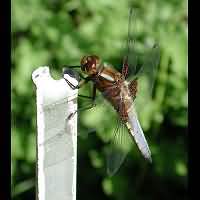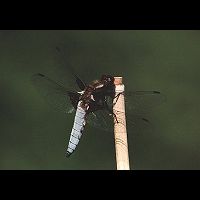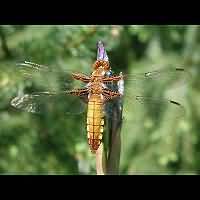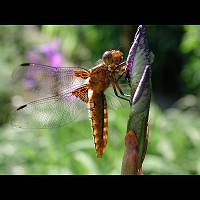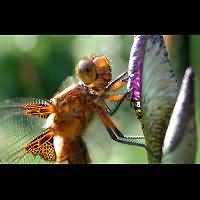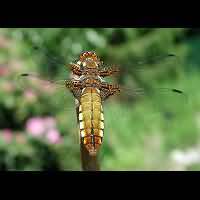[All pictures of garden wildlife on this page are thumbnails. Click on any thumbnail for a large format to be displayed.]
Broad-bodied Chaser (Libellula depressa)
The name says it all: the Broad-bodied Chaser has a very broad body indeed. Together with the big brown patches at the beginning of the wings this species is unmistakable. The hind body is brown in females and blue in males, with a number of yellow markings near the edges. In some males these patches turn blue as well, in most they don't. Very old females may turn blue too. The Broad-bodied Chaser is not very long, for it will reach a length varying from 40 to 50mm. The wingspan is relatively impressive: some 70 to well over 80mm.
The eggs are being wiped to the surface of the water. The sink to the bottom and hatch. The larvae not only live on the bottom, but also in it. New adults may appear in just one year, but the development may take two years as well. The larvae can hide deep inside the mud. In this way they are capable of living through long periods during which the pool is dried up. The Broad-bodied chaser is a pionering animal, which means it will quickly appear in new pools. It disappears once the pool gets older, especially when 50% or more is grown with plants.
Mating takes a very short time only: it is over and done with in less than one minute. The female lays her eggs alone, but the male keeps watch close by. Especially the females can be found far away from the waters they are born in. The Broad-bodied Chaser is very approachable, so it is quite easy to make beautiful pictures. And you don't have to follow the animal about, you just wait for it. On beautiful, sunny days it may suddenly appear in your garden. Unlike the darters, which are flying around almost constantly, the Broad-bodied Chaser will try to find a high object, such as a twig, flower or whatever and it will hunt from there, returning there after every succesfull or unsuccesful attack. Just move towards this point. The animal may be scared by your present at first, but that will soon end and you can make some lovely pictures indeed. This is especially true when dealing with females. Males are not only less frequent garden visitors, they are also much more restless.
The eggs are being wiped to the surface of the water. The sink to the bottom and hatch. The larvae not only live on the bottom, but also in it. New adults may appear in just one year, but the development may take two years as well. The larvae can hide deep inside the mud. In this way they are capable of living through long periods during which the pool is dried up. The Broad-bodied chaser is a pionering animal, which means it will quickly appear in new pools. It disappears once the pool gets older, especially when 50% or more is grown with plants.
Mating takes a very short time only: it is over and done with in less than one minute. The female lays her eggs alone, but the male keeps watch close by. Especially the females can be found far away from the waters they are born in. The Broad-bodied Chaser is very approachable, so it is quite easy to make beautiful pictures. And you don't have to follow the animal about, you just wait for it. On beautiful, sunny days it may suddenly appear in your garden. Unlike the darters, which are flying around almost constantly, the Broad-bodied Chaser will try to find a high object, such as a twig, flower or whatever and it will hunt from there, returning there after every succesfull or unsuccesful attack. Just move towards this point. The animal may be scared by your present at first, but that will soon end and you can make some lovely pictures indeed. This is especially true when dealing with females. Males are not only less frequent garden visitors, they are also much more restless.

© Copyright 1998-2024 gardensafari.net (Hania Berdys)

 English / engels
English / engels  Dutch / nederlands
Dutch / nederlands